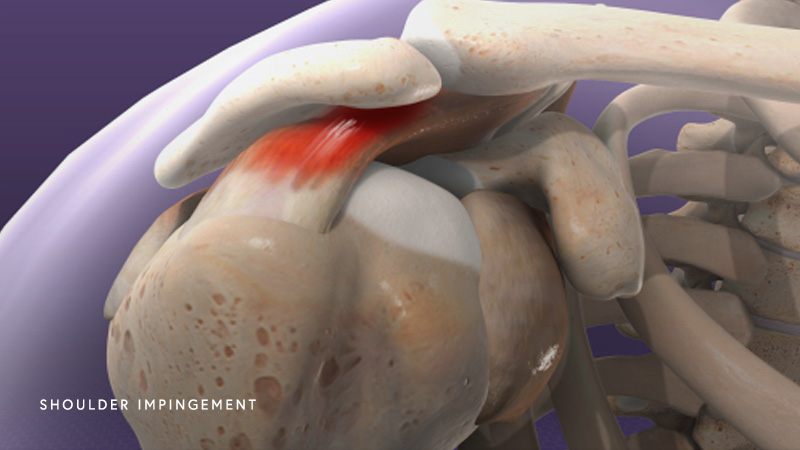Being the body’s most mobile joint, the shoulder can sustain serious injuries including shoulder impingement. An injury known as shoulder impingement refers to the impingement (pinching) of the rotator cuff tendons. The persistent, repetitive pinching causes shoulder pain, Edema, and inflammation. Due to the increased incidence of this injury among swimmers, the condition is sometimes known as “swimmer’s shoulder.”
Impingement of the shoulder can happen for no obvious reason and is extremely common. The problem develops when the rotator cuff tendons of the shoulder joint sustain damage when rubbing against the joint’s bones and ligaments. Individuals who engage in swimming and other athletic activities face an increased risk of developing ‘swimmer’s shoulder,’ a condition often triggered by repetitive movements that result in the formation of bone spurs. Additionally, age may contribute to the likelihood of experiencing this injury, as bone spurs tend to develop more commonly as individuals grow older. This ailment is also accompanied by subacromial bursitis and tendon irritation.

Overview
What is Shoulder Impingement?
Shoulder impingement occurs when the upper outer edge of your shoulder blade (scapula) presses down on the rotator cuff beneath it. Orthopedic doctor also refer to this condition as impingement syndrome or shoulder impingement syndrome. Impingement refers to the pinching or rubbing together within a joint, causing discomfort, particularly during movement.
Your rotator cuff comprises four muscles that link your shoulder blade to your upper arm bone (humerus). These muscles are essential for lifting your arm overhead and for rotating it toward and away from your body.
The rotator cuff occupies a narrow space between your humerus and the acromion (the upper part of your shoulder blade), making it vulnerable to being caught between these bones. This compression results in shoulder impingement.
If you’re experiencing shoulder pain or have difficulty moving your shoulder without discomfort, it’s advisable to seek medical attention.
Types of Shoulder Impingement
- Rotator cuff tendinitis is inflammation or irritation of the tendons that support and move your shoulder joint, specifically affecting the rotator cuff. The condition arises when these tendons become swollen due to irritation or damage, resulting in shoulder impingement.
- Shoulder bursitis is the inflammation of a bursa, which is a fluid-filled sac found in certain joints. In the shoulder, there’s a bursa situated between the rotator cuff tendons and the acromion, serving to cushion the space between them. When this bursa becomes swollen due to inflammation, it can cause symptoms of shoulder impingement.
- Acromion deformity occurs when the usual flat shape of the acromion is altered, often becoming curved or hooked. This change can result in rubbing or pinching of the rotator cuff, leading to shoulder impingement. Some individuals are naturally born with a differently-shaped acromion, while others may develop bone spurs on it as they age.
Symptoms & Causes
Shoulder Impingement Symptoms
The primary indication of shoulder impingement is a sudden onset of pain in the shoulder when raising the arm overhead or backward. Additional symptoms may include:
- Persistent, albeit mild, arm discomfort
- Pain radiating from the front of the shoulder to the side of the arm
- Increased pain intensity during nighttime
- Weakness in the shoulder or arm
Shoulder impingement pain can exacerbate during specific movements or positions, such as:
- Raising your arm above your head.
- Elevating and lowering your arm.
- Reaching for objects.
- Lying on the affected side of your body.
- Reaching behind your back, such as retrieving items from your back pocket or twisting to unzip a purse or backpack.
What is the cause of Shoulder Impingement?
Frequent cases of shoulder impingement stem from overuse. The repetitive utilization of the shoulder can induce swelling in the tendons, causing them to “catch” on the upper shoulder bone. In some instances, the cause is unknown.
Some individuals experience shoulder impingement without a clear identifiable cause (idiopathically). Additionally, sudden impingement can result from trauma, such as a fall, car accident, or sports injury.
Who is at risk?
Engaging in sports involving repetitive overhead or forceful shoulder movements poses the greatest risk of developing shoulder impingement. Common activities linked to this include:
- Swimming
- Tennis
- Baseball
Professions demanding frequent heavy lifting or extensive arm movement also elevate the risk, such as:
- Construction work
- Moving heavy boxes
- Painting
Additionally, advancing age and prior shoulder injuries, like dislocations, heighten the risk of shoulder impingement. Furthermore, individuals with an abnormally shaped acromion are at increased risk.
Diagnosis & Tests
How is it Diagnosed?
Shoulder replacement surgeon may commence by inquiring about any prior injuries and your physical activity routines. Subsequently, by physically examining- he might request you to perform various shoulder movements while they assess for any irregularities. This evaluation aids in excluding other conditions like a pinched nerve.
Imaging Tests:
- In certain instances, an X-ray may be necessary to rule out arthritis or ascertain bone alterations, such as a spur, which could precipitate impingement.
- If there are suspicions of a more severe rotator cuff injury or if a diagnosis remains elusive, an MRI scan may be employed to obtain a more detailed view of the shoulder.
- By doing an Ultrasound.
Shoulder Impingement Treatment
Non- Surgical Treatment
Various treatment options are available for shoulder impingement, tailored to the severity of the condition.
- Home care
- Rest is crucial for addressing shoulder impingement. Refrain from engaging in strenuous exercise or activities that exacerbate the pain, particularly if you’re an athlete.
- While minimizing shoulder movement is advisable, avoid immobilizing your arm completely with a sling. Doing so may lead to increased weakness and stiffness in the shoulder.
- Consider applying an ice pack to the affected shoulder for 10 to 15 minutes multiple times a day to alleviate pain and reduce any swelling.
- Physical therapy: A physical therapist will provide you with stretches and exercises aimed at enhancing the strength and flexibility of your shoulder, thus improving its range of motion. As your shoulder progresses in its healing process, the therapist will prescribe exercises designed to fortify the muscles comprising your rotator cuff.
- Steroid injection: If rest, medications, and physical therapy fail to alleviate your pain, your healthcare provider may recommend an injection containing a local anesthetic and cortisone. Cortisone is a potent anti-inflammatory medication, and injecting it into the bursa beneath the acromion can provide relief from pain.
- Surgical Treatment
- Surgery: If other treatments prove ineffective, surgical intervention may be necessary to enlarge the space around your rotator cuff. This allows for unrestricted movement without the tendons catching or rubbing against the bone. Minimally invasive arthroscopic surgery is often sufficient, although more severe cases may require traditional open surgery. However, a recent study has raised doubts about the benefits of bone removal solely for impingement.
- In rare instances of advanced shoulder impingement, where the rotator cuff tears, surgery to repair the tear is typically recommended.
- After any type of shoulder surgery, a brief period of wearing an arm sling may be necessary. Dr. Preetesh Choudhary, who is Shoulder Replacement Surgeon in Indore will determine the appropriate time for sling removal.
Recovery duration Post-surgery:
Recovering from shoulder impingement typically requires three to six months for full healing, with more severe cases potentially taking up to a year. However, you can resume your usual activities within two to four weeks. It’s important to regularly consult with your doctor to avoid overexertion, which could prolong recovery or result in additional injuries.
What Are the Side Effects of Impingement Syndrome Treatment?
The most prevalent side effects of oral anti-inflammatory drugs are upset stomach, indigestion, and headaches. However, taking these medications after meals or with food can help alleviate stomach upset. While anti-inflammatory drugs can also lead to vomiting, constipation, and stomach bleeding (ulcers), these side effects are uncommon.
The side effects of cortisone shots vary depending on the dosage and frequency of injections. Unlike cortisone pills, occasional cortisone injections rarely result in serious side effects. However, common side effects associated with cortisone pills include elevated blood sugar levels, reduced resistance to infection, weight gain, osteoporosis (bone thinning), skin thinning, cataracts, and increased blood pressure.
